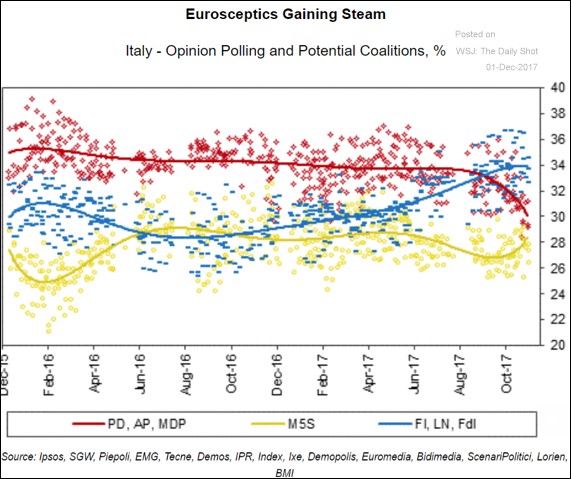Italian Election Sees Surge In Right Wing Populism
With the Italian election coming in March, we’ve discussed how a win by an unstable political party could be particularly harmful to Italian bonds because the ECB will be cutting its bond buying in half. Since the last time we’ve check on Italian politics, the trend towards populism and Euroscepticism has continued. This is surprising because the economy has had a decent year. Usually you’d expect descent when the economy is weak. One can only wonder what will happen if a recession occurs. Goldman is predicting weakness in the Italian economy next year, which might fuel populism further. The youth unemployment in the south, particularly Sicily, is very high. That is one issue politicians running in the election will claim they can solve. The chart below aims to group the populist parties and the establishment ones in coalitions. The red is the establishment and the blue is the anti-establishment somewhat right-wing coalition. The 5 Star Movement, which is the yellow line, is also a populist party, but it’s not expected to join a coalition with the other parties. The coalitions will partially depend on the results of the election. If you were to extend the trends until the election on March 15th, Matteo Renzi’s Democratic Party would have a very bad night. It’s currently polling at the lowest percentage since 2013.

Millennials Buying Houses Again?
There’s a popular meme about how millennials aren’t buying houses; it claims millennials are responsible for the tiny home trend and the surge in RV buying because they can’t afford houses. They are getting married later and having kids later which further pushes off home buying. The chart below takes a swing at that meme as it shows the changes in home ownership rates among those ages 20-35 from 2006 to 2016. This chart shows the increases in home ownership rates as the age groups get older. Clearly, the rates were hurt by the financial crisis, but they have rebounded in all the age groups. You can see from the chart that the 28-29 ~> 30-31 group saw a large acceleration in home ownership gains which is a good sign. There’s no question that millennials are still buying homes later in life. The point of this chart is to show they have a pulse when it comes to home ownership. It’s unfortunate that the losses from the financial crisis haven’t been fully recovered even though 2016 is 7.5 years after the expansion started.











Leave A Comment